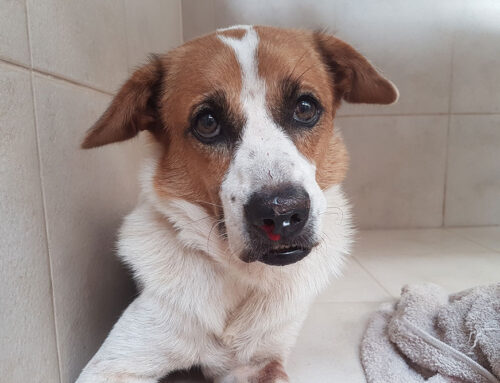When Pets Feel Overwhelmed: Recognizing and Relieving Stress in Dogs and Cats
The fireworks start, and your dog disappears into the closet, trembling. Guests arrive, and your cat vanishes under the bed, refusing to come out until the house is quiet again. These are not signs of bad behavior- they are natural stress responses. Just like people, dogs and cats experience anxiety, and they often show it in ways that can be easy to miss or misinterpret.
At North Waterloo Veterinary Hospital in Elmira, Ontario, we know that stress affects not only how pets feel in the moment but also their long-term health. Recognizing the signs early, understanding why they occur, and knowing how to help can make home life calmer and veterinary visits easier.
Common Signs of Stress in Dogs
Dogs use body language and behavior to communicate discomfort. Signs include:
- Physical changes such as pacing or restlessness that never settles, panting without exertion, drooling, trembling, or sudden shedding
- Excessive vocalization, including whining or barking when alone
- Destructive behavior, like chewing door frames during storms
- Avoidance gestures, such as cowering or hiding when approached
- Reactive behavior toward other animals or people
Signs of Stress in Cats
Cats are experts at hiding discomfort, so the signs can be more subtle:
- Changes in litter box use, such as urinating outside the box
- Overgrooming, sometimes to the point of bald spots
- Hiding for long periods in quiet spaces
- Aggression, including swatting or hissing
- Vomiting or changes in appetite
Why Pets React the Way They Do: Fight or Flight
When an animal feels threatened, the body automatically prepares for fight or flight. Most pets will choose to retreat if they can. A dog with noise aversion chewing through a door frame during a thunderstorm or a cat hiding under the bed during a party is responding to a strong instinct to escape danger.
But when escape is impossible, fight may feel like the only option. This is why dogs on leash sometimes react aggressively toward other dogs– the leash removes the option of flight. Similarly, when a cat swats at another pet that gets too close, it is often because running away may trigger a chase, which feels more dangerous. Understanding this natural instinct helps explain why pets respond the way they do and guides us in creating safer, calmer environments.
Underlying Causes of Anxiety
Anxiety is usually a mix of environment, experience, and health.
Genetics
Some breeds are more prone to stress-related conditions. Herding breeds, for example, may be genetically wired for sensitivity to sound and movement, while certain cats are naturally more cautious or reactive. Anxiety can be passed generationally as well- pets with significant anxiety should not be used for breeding.
Inadequate Socialization
Puppies and kittens that miss early socialization windows often develop lifelong fears. Following socialization guidelines can reduce this risk.
Environmental Changes
A move, home renovation, or new family member (pet or human) can trigger stress. Loud construction and new babies are common examples.
Boredom and Lack of Enrichment
Without enough outlets, pets turn to destructive or anxious behaviors. This is especially common for high-drive, young dogs like herding and working breeds who need both exercise and mental challenges.
Medical Conditions
Pain and illness can be mistaken for stress, or may worsen it.
- Common pet pain signs include reluctance to jump, changes in posture, or withdrawal. In cats, the Feline Grimace Scale helps identify discomfort.
- Hyperthyroidism in cats often causes restlessness, irritability, and vocalization.
- Cognitive dysfunction syndrome can lead to confusion, pacing, or nighttime anxiety for both dogs and cats.
Helping Pets Cope
There are many ways to support anxious pets at home.
Predictable Routines
Regular feeding, play, and rest times help pets feel secure. Introduce changes gradually when possible.
Safe Retreats
Dogs need quiet resting spots, and cats benefit from elevated perches or hideaways. These spaces give them the option to retreat instead of reacting. Cats also thrive in environments designed to support their natural behaviors. The Indoor Pet Initiative recommends vertical perches, safe hiding areas, and multiple litter boxes.
Daily Enrichment
Rotate toys, use puzzle feeders, and create opportunities for mental engagement. Activities such as dog enrichment games, puzzle feeders, or DIY cat toys prevent boredom and reduce stress.
Positive Training
Reward calm, confident behaviors with treats and praise. Using a positive training philosophy builds trust without punishment and helps pets develop resilience. The engage-disengage game is a great way to start positive training for common stress triggers, like other pets.
When to Seek Veterinary Help
Every pet has occasional moments of stress – a loud noise, a new visitor, or a change in routine. But when anxiety becomes persistent or begins to disrupt daily life, it is time to seek professional help. Signs that your pet may need veterinary attention include:
- Aggression or destructive behavior that continues despite training or environmental adjustments
- Appetite changes, vomiting, or litter box problems that last more than a day or two
- Withdrawal from normal activities, such as refusing to play, hiding for long periods, or avoiding family interaction
- Compulsive behaviors, like excessive licking, spinning, or pacing, that don’t improve with redirection
- Excessive vocalization such as howling, barking, or meowing that goes beyond normal communication
- Sudden changes in mood – for example, a normally friendly dog snapping when approached, or a cat becoming unusually irritable
A veterinary exam helps rule out underlying health conditions, since issues like arthritis, gastrointestinal disease, or hyperthyroidism can look like stress or worsen existing anxiety. Your veterinarian can then guide you toward the right mix of behavioral strategies, environmental changes, and medical support tailored to your pet’s needs.
Medical and Supplement Support
For some pets, home strategies alone are not enough. Veterinary support can provide relief while you work on long-term solutions. Options may include:
- Supplements such as calming chews, pheromone diffusers, or omega-3 fatty acids, which can take the edge off mild anxiety
- Nutraceuticals like L-theanine or alpha-casozepine, which promote relaxation without sedation and may be used daily in pets with frequent stress
- Dietary adjustments that include specially formulated calming diets or added nutrients to support brain health
- Prescription medications for pets with moderate to severe anxiety, or those whose stress puts their safety at risk. These can help reduce the intensity of fear responses and make training more effective. In some cases, short-term medications are used for predictable stressors such as fireworks or veterinary visits, while long-term medications may help with chronic anxiety.
- Pain management, since conditions like arthritis, dental disease, or injuries can heighten stress and make pets less tolerant of everyday events
Your veterinarian will recommend a plan based on your pet’s age, health, and lifestyle. The goal is never to “medicate away” personality, but to reduce suffering and create a calmer state of mind so your dog or cat can learn, adapt, and enjoy life more fully.

Supporting Emotional Wellness at North Waterloo Veterinary Hospital
Stress and anxiety are not just quirks of personality – they are signals that your pet needs extra support. With the right combination of routine, enrichment, and veterinary guidance, most dogs and cats can feel calmer, safer, and more confident in their daily lives.
At North Waterloo Veterinary Hospital, we emphasize compassionate, individualized care. As a cat-friendly practice with experienced team members, we create a safe environment for even the most anxious pets. From puppy and kitten programs to senior wellness, our goal is to help pets thrive at every stage of life.
If you are worried about your pet’s stress or anxiety, call us at 519-669-2901. Together, we can find solutions that make life at home more peaceful and veterinary visits more comfortable, so your pet can enjoy the calm, happy life they deserve.







Leave A Comment